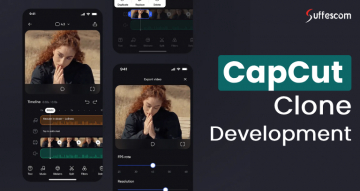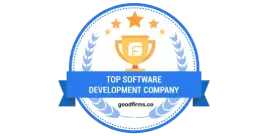Build a Patreon Clone to Monetize Creator Communities

More and more people today want to earn money from their skills and content. As a result, many enterprises now wish to develop a platform like Patreon. They want their own Patreon clone to build a secure space for creators and their communities.
The creator economy is growing very fast, with estimates that it will cross $1300 billion in 2033 and continue to rise each year. This growth is happening because creators now want a direct way to earn from their audience. They no longer rely only on ads or third-party platforms.
Patreon has already proven its reach in the market. It's a subscription based platform that allows content creators to generate revenue. It lets fans pay a monthly fee in order to access exclusive content. This model works for writers, videographers, musicians, podcasters, web comic artists, video game developers, and even adult content creators.
You will learn with us what it takes to develop patreon like subscription-based creator platform, what features are required, how it works, and how you can get started with it.
Why Developing a Patreon-Like Platform Is a Profitable Move
What creators want today is more control: a steady income, a loyal community following, and a safe space to publish content. A Patreon clone platform does this.
Here's why building a Patreon clone development project makes sense:
- The subscription model creates predictable recurring revenue.
- The creators will be fairly compensated for the work that they have done.
- It enables businesses to sell to niche creator markets: from fitness coaches to artists, adult content creators, and online educators.
- You can customize, as opposed to third-party platforms.
If you create monetization platform like Patreon, it is a win-win model for everyone. Creators can earn more, fans can get more exclusive content, and platform owners can earn through commissions or subscription fees.
First Strategy: Niche + Monetization Planning
It is important to decide what type of platform you want to build before starting Patreon Clone development.
First, ask yourself:
- Do I want to support all types of creators?
- Or do I want to focus on one niche?
Some entrepreneurs build a white label Patreon like platform only for musicians. Some build for adult content creators because there is high demand and fewer restrictions. And some want to build a white label app for multiple creators.
Next is considering which revenue model you will use:
- Subscription fees
- Commission on creators' earnings
- Paid posts
- Donations and tips
- Digital product sales
That way, choosing these things early will help shape the platform, features, and user experience.
Core Features Required to Develop a Patreon-Like Platform
For content-sharing platform development like Patreon, you need to have some features supporting creators, fans, and the owners. These features support smooth interaction between everybody, from creating content to managing subscriptions. The platform should include:
1. Profile & Identity Setup
A creator-dedicated profile space allows them to introduce themself, display their work, and point out the perks for the members. This page becomes their public identity and helps draw in paying subscribers.
2. Content Upload & Publishing Tools
Creators should have the option of uploading content quite easily, for instance, in the forms of videos, posts, PDFs, podcasts, and images. The whole process has to be very easy so that the spotlight remains on the creators and not on using complex tools.
3. Subscription Tiers & Monetization Settings
Memberships based on tiers give creators the ability to grant varied perks to their supporters. This way, the fans can pick the plan that suits them the best while providing the creators with more earning options through exclusivity and rewards.
4. Community Interaction & Messaging
Feedback, reactions, and simple conversations are the ways to get closer to the portal of your favorite celebrities. These tools of communication help keep interactions alive, questions get answered, and a loyal community is built around that artist.
5. Smooth Onboarding & Login Experience
Signing up through email, mobile verification, or social logins would be the quickest and simplest way for the fans to become members. A hassle free onboarding experience not only increases conversion rates but also engages the users.
6. Flexible & Secure Payments
The platform should guarantee secure payments via recurring billing, credit cards, wallets, or subscription gateways. Consequently, the fans’ support of the creators will be painless, and the payment renewals will be hassle-free.
7. Exclusive Content Access
The moment fans sign up, they ought to have access to the posts, benefits, and digital goodies that were previously hidden. This premium service turns the platform into a better place, and hence, more people are likely to become and stay members over the long run.
8. Notifications & Updates
Fans should be notified every time the creator adds new content or changes something. These kinds of reminders will keep the fans interested and will make sure that they always know what is going on with the creator's posts.
9. Admin Dashboard & Platform Controls
Admin will always have a centralized dashboard where he/she can see and manage everything related to creators, users, content, payments, and platform settings. This is the reason why everything seems perfect from the user’s end.
10. Earnings, Payouts & Revenue Monitoring
The platform must be able to automatically monitor and record commission, subscription income, refunds, and payouts. This increases the level of trust between the creators and the platform owners.
11. Security & Compliance Options
Moderation, restricted access, age filters, and content policies are some of the admin controls that are a must to have, especially if adult creators are allowed on the platform. The mentioned settings play a very important role in making the platform safe and compliant.
As your platform grows, you can add more advanced features to it, like live streaming, fan badges, merchandise shops, access to NFTs, and analytics.
Build a Fully Custom Feature-Rich Patreon Clone Now
Access premium capabilities, including content scheduling, analytics dashboards, secure payments, multi-tier memberships, and complete admin control to suit your business model.
Advanced Features & Add-Ons to Scale Patreon Clone
After your basic Patreon-like platform has gone live, it can be enhanced with powerful add-ons that will increase engagement, monetization, and user satisfaction..
Advanced upgrades:
1. Live Streaming & Virtual Events
Creators can also host real-time sessions through a live streaming product selling app, where fans can buy digital or physical products directly during the stream. Along with this, creators can organize live Q&A sessions, private concerts, classes, or exclusive fan meetups.
2. AI-Based Content Recommendations
The system presents personalized content suggestions to users in light of their interests and activity. This promotes more visibility among creators by raising the retention rate.
3. Gamification Tools
Badges, points, and ranking systems make the platform more interactive and fun. Fans stay motivated to engage in supporting and unlocking rewards.
4. Built-in marketplace for physical & digital products
You can sell merchandise, ebooks, templates, courses, presets, or downloadable assets. This provides an additional channel of earning apart from subscriptions.
5. NFT memberships and blockchain wallets (optional)
Token-based access, special NFT passes, and ownership-based tiers are just a few options for creators. Optional, but ideal for users who want Web3 streaming platform monetization.
6. Multi-Language and Multi-Currency Support
This feature helps your platform grow beyond local users, reaching international creators and subscribers with ease. It makes onboarding seamless for a global audience.
Development Models for Patreon Clone: Select the Way You Want to Build
It is not important that everyone choose the same path to create platform like Patreon. Everybody is free to select an appropriate development model, taking into consideration their timeline, budget, and goals. Each option has its considerable pros and cons. So, at the end, this depends on whether you want to launch faster or build a fully customized solution.
Let's go through some of the most prevalent development pathways:
1. Patreon Clone Development
By pre-building an entire base solution, this option lets you launch faster with important features like subscription tiers, creator dashboards, and secure payments. With a Patreon clone script, you have a great starting point from which you can make modifications according to your needs.
2. MVP Version of the Clone
An MVP allows you to launch with only the necessary features. It helps you to test your idea in the real market before investing in it as a full product. It allows creators to start earning and gives them feedback for shaping the next development steps.
3. Custom Clone Development
In cases where one wants unique branding, exclusive features, or niche specific functionality, a custom clone is the best choice. You can build platforms that cater to very specific creators, such as fitness professionals, streamers, podcasters, or even adult content creators.
4. White Label Patreon Clone
A white label Patreon clone is already available, a developed platform which can then be rebranded with your business name. Ready-to-Launch White Label Patreon Like Platform is best for quick set-up, for entrepreneurs who want a ready platform without long development cycles.
5. No-Code Patreon Clone Development
If you intend to experiment or launch fast and without coding, hiring our no-code app developers to get a no-code clone is a good entry point. It does not require technical development for the deployment of basic features, though customization and scaling might be limited.
Each model caters to a different stage of your business, from idea validation to a full scale launch. You can also start with one approach and later upgrade as the platform grows.
Scale Faster With A Ready-To-Launch Patreon Clone
Accelerate your platform launch with a pre-built foundation designed for subscriptions, fan engagement, and seamless creator monetization with Suffescom.
How to Build a Scalable Patreon Clone: Process We Follow
There are primarily two ways to develop a Patreon clone platform. First, it can be developed from scratch. You will have complete flexibility, a unique design, and full control of the features. The second option is you can use a ready Patreon clone script that helps you launch faster and reduces development time and cost.
If you need a long-term, scalable platform with custom branding, then custom development will be the ideal approach. If you look to launch quickly with essential features, then a clone script would be the practical option.
Basic Development Steps:
Step 1: Define Target User & Features
First, determine who your platform is going to support because some of the platforms support all content creators, while others focus on specific niches like gamers, writers, musicians, podcasters, and adult content creators. These are the most famous examples. So, once you define the target groups, it is possible to finalize the feature list.
Step 2: UI/UX Design
Now, let the user flows be clean and simple, and the page navigation to be easy- login, creator profiles, subscription tiers, dashboards, and content feeds. The more enjoyable the experience is, the more engagement and conversions will be the result.
Step 3: Core Feature Development
The design signifies to the developers that they can now start developing the functionalities of the primary features. This comprises subscription tiers, dashboards, payment gateways, content publishing tools, and messaging systems. These core features are the skeleton to create platform like Patreon.
Step 4: Testing
They will be doing the testing of the mobile, tablet, and desktop versions of the features developed. Testing would assist in bug detection, impression error fixing, and performance checking before the rollout.
Step 5: Launch as MVP
Now the platform is ready for a basic release. MVP app development provides you with an early version that helps you see how creators and fans use the product and what improvements are needed.
Step 6: Upgrade & Scale
The addition of cutting-edge features, UI improvement, and performance enhancement can be done post-launch based on actual user feedback and growth.
For instance, if the platform permits adult content creators, you will also need extra compliance features such as compulsory age verification, content restrictions, and legal payment gateways. All this will contribute to the platform's safety, trustworthiness, and compliance.
Turn Engagement Into Income With Patreon Clone Revenue Strategies
With a Patreon like subscription backed creator platform, there are various ways to generate income. Since more creators and fans join your platform, your revenue naturally increases. The key is actually offering value, flexibility, and tools that help creators grow. Here are some of the most commonly used earning methods you can get:
1. Commission on Creator Earnings
This is the most popular model. The platform takes a small fraction from the monthly earnings of every creator. Since creators grow their audience, your revenue increases automatically without any extra work.
2. Creator Subscription Fee
With the freemium model, creators can pay a monthly or annual fee to get advanced tools such as analytics, premium themes, or additional storage. This model works when the platform offers strong professional features.
3. One-Time Paid Posts
Fans can also buy single locked posts without subscribing. This is helpful when creators offer special content, such as tutorials, wallpapers, or exclusive releases.
4. Tips and Donations
Fans can send extra support anytime. Such micro-payments will drive more engagement and give additional motivation for creators to keep up their active status.
5. Online Marketplace for Digital Products
Users can offer their digital products like music tracks, e-books, merchandise, templates, courses, or even one-off downloads for sale. The site may also get a fee or commission per transaction.
6. Advertisements or Brand Partnerships
If your platform attracts niche creators, then brands might pay either for ad placement or sponsored content. This adds another revenue channel, especially as traffic grows.
With multiple income options, your Patreon clone platform is sure to scale steadily. The more creators earn, the more the platform benefits, thereby making it a win-win model for all.
Creators Convert Their Creativity Into Revenue with Patreon Clone
Development of a Patreon Clone empowers creators with tools for content access control, community building, fan loyalty, and monthly recurring earnings.
Recommended Tech Stack for Patreon Clone Development
To build a fast, scalable and secure Patreon platform, it is essential to choose the right technology stack. Below, we provide you with a simple breakdown of the recommended setup:
| Category | Recommended Technologies |
| Frontend | React.js, Next.js, Vue.js |
| Backend | Node.js, Laravel, Django, Ruby on Rails |
| Database | PostgreSQL, MongoDB, MySQL |
| Cloud Hosting | AWS, Google Cloud, Azure |
| File Storage / CDN | AWS S3, Cloudflare, Firebase Storage |
| Payments | Stripe, PayPal, Razorpay, Coinbase Commerce (optional) |
| Streaming & Media Processing | AWS IVS, Vimeo API, Agora, Twilio |
| Authentication | OAuth, Firebase Auth, AWS Cognito |
| Security & Compliance | SSL Encryption, JWT Authentication, PCI-DSS Standards |
This stack supports fast development, easy scaling, and secure financial transactions, all essential for developing a Patreon clone.
How a Subscription-Based Creator Platform Like Patreon Clone Works
A subscription based platform works in a simple, highly predictable flow. Such subscription based creator platform is designed with the goal of making it easy for creators to share content and fans to subscribe and support them.
Here is how it usually works:
- Creators sign up & set up a profile
- They create membership tiers and upload gated content
- Fans subscribe and unlock exclusive access
- Content is delivered through feed, livestream, downloads, or chat
- Recurring payments are processed automatically
- Creators receive payouts after platform commission
Patreon Clone Development Cost & Launch Timeline
The Patreon-like platform's cost and time will depend on the complexity, features, and the development method used. It’s important to understand these factors to enable proper planning and the avoidance of any surprises financially.
The foundation version is less costly, as it only comprises the most required features. When you begin to bring in more sophisticated instruments like AI analytics, live streaming, mobile apps, or NFT memberships, the price automatically increases.
An MVP or clone script is the faster option for development time, while a fully custom solution takes longer as everything is built according to your unique requirements.
Here’s a general overview of the development cost estimate:
1. Basic platform or MVP: Lower cost, ideal for early testing or niche creator communities
2. White Label Patreon Clone: A cost-effective option with a ready-made, quick-launchable app.
3. Mid-tier custom clone: Slightly higher cost than MVP but with greater functionality, branding, and integrations.
4. Fully customized advanced platform: Custom app development is costly, but it includes mobile apps, streaming, marketplaces, analytics, and scaling features.
Prices vary depending on the region, size, and customization requirements.
Turn Loyal Fans Into Superfans With Patreon Clone Exclusive Access
Allow creators to reward their most engaged supporters through gated content, VIP experiences, early releases, and personalized interactions.
Segment of Creators Supported by Patreon-Like Platforms
A Patreon like platform is built for creators who want to earn directly from their audience. In place of ad revenues or brand deals, creators can create paid communities and sell exclusive content.
Such a platform helps a lot of categories of people, including niche creators, influencers, and emerging talent.
Here are some popular segments that it supports:
- Writers & Bloggers
- Podcasters & Musicians
- YouTubers, Gamers & Streamers
- Videographers, webcomic artists & designers.
- Coaches, Teachers & Educators
- Adult Content Creators
- Yoga and meditation instructors
- Digital product sellers
- Motivational speakers and influencers
- Fitness trainers
Marketing Plan: How to Launch and Scale a Patreon Clone
That is the first step to building a Patreon-like platform. Obviously, none of the creators or fans will come unless you actually market it. The right strategy helps in creating awareness, trust, and long-term growth.
1. Target Creator Communities
First, it is about reaching out to online communities where creators already exist, on platforms like YouTube, Instagram, Twitch, and Reddit. These creators are already accustomed to subscription-based models and are likely to join early.
2. Social Media Marketing
Disseminate the information over social media platforms like TikTok, X (Twitter), Facebook, and LinkedIn through updates, tutorials, and dramatic success stories. You can present the information in a very simple and short form that will attract the attention of the people and drive traffic to the site.
3. Creator Referral Program
Offer rewards or bonuses whenever creators invite other creators or fans. Referral programs are similar to word of mouth marketing, which helps your platform grow faster.
4. Educational Content & Tutorials
It helps the new generation of creators to know the tricks of the trade via blogs, videos, and guides: drawing an audience, fixing subscription levels, and making money. If you provide info to the fans, there are chances that they'll be around you.
5. Paid Ads & Influencer Partnerships
Paid ads and influencer marketing are other ways to quickly spread the message to more people. Partnerships with niche creators also help the platform gain credibility.
Through a consistent marketing approach, new creators discover the platform, get attracted, and eventually join and engage.
Regulatory Requirements to Follow for Developing a Patreon Clone
Legal requirements are quite important when you develop patreon like subscription-based creator platform. These rules protect both the platform and the creators/fans using it. They also help in trust building and staying clear of penalties. Understanding and following compliance early saves time, cost, and stress later.
Key legal and compliance areas:
1. Age verification controls
Age checks are needed if your Patreon-like platform allows adult creators or sensitive content. This prevents minors from accessing or publishing restricted content and keeps the platform safe and compliant.
2. Strong community rules and moderation tools
Clear policies reduce harmful or illegal content. Moderation tools, such as AI flagging, reporting features, and admin review, all help keep the environment safe and respectful.
3. Secure and Compliant Payments
Features including PCI compliance, AML checks, and KYC for creators help prevent fraud and make payment partners trust your platform.
4. Copyright and ownership clarity
The ownership of content should be clear to the creators themselves. Your platform policies should give details on how licensing, rights, and usage work so that copyright disputes do not arise.
5. Data protection and privacy laws
The crucial rules are GDPR, CCPA, and the like when it comes to handling user data. Safe storage, consent based gathering of data, and transparency build trust.
Your Patreon clone platform becomes safer, trustworthy, and reliable for creators and fans with the right compliance structure.
Create a Safe, Private Space for Exclusive Creator Communities
Build a secure, membership-based environment where creators can share content, host discussions, and nurture loyal fans without noise, distractions, or algorithm pressure.
Common Roadblocks & Solutions in Patreon Clone Development
The process of building a subscription-based creator platform like Patreon comes with challenges, but they can be handled through the right planning and the right strategy. Most challenges show up in the launch and early growth stages. Knowing them early helps you avoid mistakes.
Challenge: Balancing creators and fans
Solution: Creators join when there are fans, and fans join when there is content. Follow a focused niche, and support early creators till momentum builds.
Challenge: Keeping creators active
Solution: Consistency is key on creator platforms, so offering reminders, training, and posting tools keeps creators motivated and publishing.
Challenge: Payment issue handling
Solution: Fraud, chargebacks, and payout delays drive people frustrated. Be trusted with more gateways and secure wallets.
Challenge: Managing platform load and storing media
Solution: More videos, images, streams, and so on can make the servers slow. Scalable cloud hosting helps maintain smooth performance.
Challenge: Standing out from the competition
Solution: There are many Patreon like platforms. A niche focus or unique features, such as AI tools, events, or exclusive membership perks, will give you an edge.
If you cater to adult creators, there would be many restrictions that you face, like gateway restrictions, branding concerns, and stricter compliance. A verified vendor network can solve these challenges.
What Makes Suffescom the Best Partner for Patreon Clone Development
Developing a subscription-based creator platform requires more than development; it requires planning, strategy, and experience. That is where Suffescom stands out as the perfect partner.
We blend technical expertise with industry understanding to help you build a scalable and revenue–ready creator platform.
1. Platforms in the Creator Economy
Our team has had many subscription platforms, white-label Patreon clone solutions, membership systems, and digital creator tools. These paths provide us with an understanding of real-world problems and their quick solutions.
2. Custom Development + Ready-Made Script Options
Whether you wish to quickly launch with the help of a pre-built Patreon clone script or require a fully customized solution, both options are available. You will only pay for what is in line with your business vision.
3. Strong Security, Compliance & Payment Expertise
We keep on following the secure practices, putting in place age verification, KYC/AML, PCI compliance, GDPR standards, and integrating the safe gateways that ensure not only your platform's safety but also its full compliance with global regulations.
4. Future-Ready Scalability
Your platform is not going to remain small forever. We use scalable infrastructure, so your application performs smoothly, even with increasing content or users.
5. End to End Support
We will give you support throughout the entire process, from idea to post launch improvements. You can expect continual upgrades, maintenance, and support to make sure your platform remains competitive.
If you are working with Suffescom, it means you are building smarter, scaling faster, and reducing risks, all while aligning with your long-term business goals.
Develop Patreon Like Subscription-Based Creator Platform With Us Today
If you have an idea, now it's time to convert it into a successful digital platform. Whether you want to develop a niche specific Patreon Clone or for all creators- global subscription product, we are here to help. Suffescom, a reliable clone app development company, makes your vision a leading platform in the creator economy.
You can launch, grow, and scale confidently if your solution is backed by the right support and technology. Together, let us build something meaningful, profitable, and future ready.
Book a Free Demo
FAQs
1. What is a Patreon clone and why should I build such an app?
Patreon clone is the kind of platform that is very much like Patreon and allows the same activities which are done by the artists through subscriptions, tips, and paid posts. It allows the owner to have the power of branding, rules, monetization, and audience. This model is gaining a lot of popularity as the creators are looking for more such platforms where they would be able to share the revenues and get the flexibility.
2. What important features would you want a Patreon like platform to have?
A system of Subscription tiers, creator dashboards, messaging, content uploads, analytics, and secure payments is the main feature of the platform. You may then broaden this offering through live streaming, merch sales, NFTs, badges, or community tools in order to up the engagement and revenue.
3. Should I use a clone script or build from scratch?
A Patreon clone script would be faster and cost-effective to bring your platform live. It would include essential features, which can be customized further according to needs. In fact, this is an approach that is perfect for MVP testing or early-stage launch prior to the investment for full custom development.
4. How much does development cost, and how long does it take?
It generally depends on features like complexity and customization meaning that the cost will not be the same for every development. Basic versions will require a lower investment, while fully advanced platforms will cost more. A simple MVP may take 3–6 months, while a full solution can take 6–12 months depending on features and scale.
5. How do I attract creators and fans to my platform?
Marketing brings users, as do partnerships, SEO, and referral incentives. Choosing a niche first also builds focus and thus faster adoption. When creators see real earnings and engagement, they stay, grow, and naturally bring more users in.
6. What monetization models work best in Patreon Clone?
Some of the frequently used monetization models are commission fees, platform subscriptions, paid posts, tips, donation systems, and selling digital products. You may also establish paywalls, membership badges, or marketplace fees to boost your long term income.
7. What are the legal requirements one must meet to create platform like Patreon Clone?
Age verification, content moderation rules, and secure payments are some of the requirements that you may have to meet. Regulations can vary by region and type of content, especially if you are including adult creators.
8. Which is the best company for Patreon Clone development?
Suffescom is a reliable name for developing a Patreon Clone. We take care of the development, scaling, security updates, feature upgrades, and maintenance that will ensure your platform stays in tune with the increasing demand of the users. Along with the support, we plan improvements, integrations, and optimizations based on the actual usage data.






